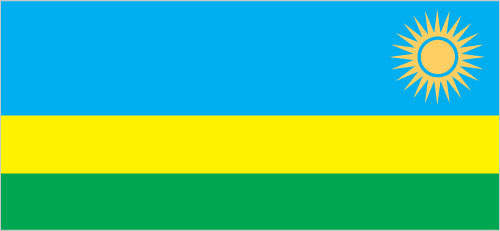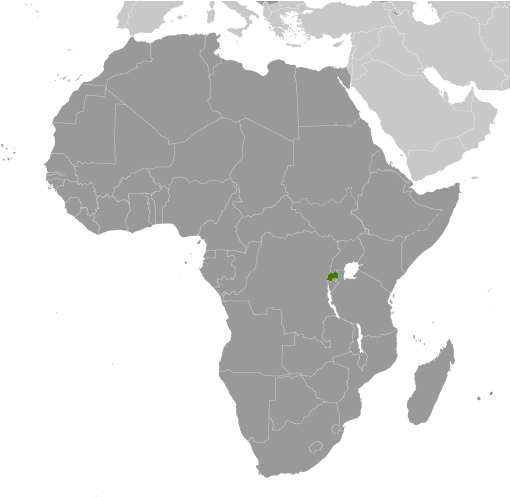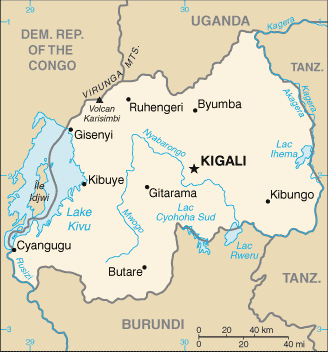|
Economy - overview:
|

|
|
Rwanda is a poor rural country with about 90% of the population engaged in (mainly subsistence) agriculture and some mineral and agro-processing. Tourism, minerals, coffee and tea are Rwanda's main sources of foreign exchange. Minerals exports declined 40% in 2009-10 due to the global economic downturn. The 1994 genocide decimated Rwanda's fragile economic base, severely impoverished the population, particularly women, and temporarily stalled the country's ability to attract private and external investment. However, Rwanda has made substantial progress in stabilizing and rehabilitating its economy to pre-1994 levels. GDP has rebounded with an average annual growth of 7%-8% since 2003 and inflation has been reduced to single digits. Nonetheless, a significant percent of the population still live below the official poverty line. Despite Rwanda's fertile ecosystem, food production often does not keep pace with demand, requiring food imports. Rwanda continues to receive substantial aid money and obtained IMF-World Bank Heavily Indebted Poor Country (HIPC) initiative debt relief in 2005-06. In recognition of Rwanda's successful management of its macro economy, in 2010, the IMF graduated Rwanda to a Policy Support Instrument (PSI). Rwanda also received a Millennium Challenge Threshold Program in 2008. Africa's most densely populated country is trying to overcome the limitations of its small, landlocked economy by leveraging regional trade. Rwanda joined the East African Community and is aligning its budget, trade, and immigration policies with its regional partners. The government has embraced an expansionary fiscal policy to reduce poverty by improving education, infrastructure, and foreign and domestic investment and pursuing market-oriented reforms. Energy shortages, instability in neighboring states, and lack of adequate transportation linkages to other countries continue to handicap private sector growth. The Rwandan government is seeking to become regional leader in information and communication technologies. In 2010, Rwanda neared completion of the first modern Special Economic Zone (SEZ) in Kigali. The SEZ seeks to attract investment in all sectors, but specifically in agribusiness, information and communications technologies, trade and logistics, mining, and construction. The global downturn hurt export demand and tourism, but economic growth has recovered, driven in large part by the services sector, but inflation has grown. On the back of this growth, government is gradually ending its fiscal stimulus policy while protecting aid to the poor.
|
|
|
GDP (purchasing power parity):
|

|
|
$14.91 billion (2012 est.)
country comparison to the world: 141
$13.84 billion (2011 est.)
$12.75 billion (2010 est.)
note:
data are in 2012 US dollars
|
|
|
GDP (official exchange rate):
|

|
|
$6.95 billion (2012 est.)
|
|
|
GDP - real growth rate:
|

|
|
7.7% (2012 est.)
country comparison to the world: 20
8.6% (2011 est.)
7.2% (2010 est.)
|
|
|
GDP - per capita (PPP):
|

|
|
$1,400 (2012 est.)
country comparison to the world: 203
$1,400 (2011 est.)
$1,300 (2010 est.)
note:
data are in 2012 US dollars
|
|
|
GDP - composition by sector:
|

|
|
agriculture: 33.3%
industry:
13.9%
services:
52.9% (2012 est.)
|
|
|
Labor force:
|

|
|
4.446 million (2007)
country comparison to the world: 85
|
|
|
Labor force - by occupation:
|

|
|
agriculture: 90%
industry and services:
10% (2000)
|
|
|
Unemployment rate:
|

|
|
NA%
|
|
|
Population below poverty line:
|

|
|
44.9% (2011 est.)
|
|
|
Household income or consumption by percentage share:
|

|
|
lowest 10%: 2.1%
highest 10%:
43.2% (2011 est.)
|
|
|
Distribution of family income - Gini index:
|

|
|
46.8 (2000)
country comparison to the world: 32
28.9 (1985)
|
|
|
Investment (gross fixed):
|

|
|
22.1% of GDP (2012 est.)
country comparison to the world: 71
|
|
|
Budget:
|

|
|
revenues: $1.788 billion
expenditures:
$1.911 billion (2012 est.)
|
|
|
Taxes and other revenues:
|

|
|
25.7% of GDP (2012 est.)
country comparison to the world: 119
|
|
|
Budget surplus (+) or deficit (-):
|

|
|
-1.8% of GDP (2012 est.)
country comparison to the world: 80
|
|
|
Public debt:
|

|
|
21.8% of GDP (2012 est.)
country comparison to the world: 127
24.5% of GDP (2011 est.)
|
|
|
Inflation rate (consumer prices):
|

|
|
8.5% (2012 est.)
country comparison to the world: 187
4.9% (2011 est.)
|
|
|
Central bank discount rate:
|

|
|
7.75% (31 December 2010 est.)
country comparison to the world: 20
11.25% (31 December 2008)
|
|
|
Commercial bank prime lending rate:
|

|
|
17.5% (31 December 2012 est.)
country comparison to the world: 27
17.4% (31 December 2011 est.)
|
|
|
Stock of narrow money:
|

|
|
$673.2 million (31 December 2012 est.)
country comparison to the world: 156
$593.2 million (31 December 2011 est.)
|
|
|
Stock of broad money:
|

|
|
$1.536 billion (31 December 2012 est.)
country comparison to the world: 157
$1.324 billion (31 December 2011 est.)
|
|
|
Stock of domestic credit:
|

|
|
$711 million (31 December 2012 est.)
country comparison to the world: 164
$612.9 million (31 December 2011 est.)
|
|
|
Market value of publicly traded shares:
|

|
|
$NA
|
|
|
Agriculture - products:
|

|
|
coffee, tea, pyrethrum (insecticide made from chrysanthemums), bananas, beans, sorghum, potatoes; livestock
|
|
|
Industries:
|

|
|
cement, agricultural products, small-scale beverages, soap, furniture, shoes, plastic goods, textiles, cigarettes
|
|
|
Industrial production growth rate:
|

|
|
7.5% (2010 est.)
country comparison to the world: 33
|
|
|
Current account balance:
|

|
|
-$657.8 million (2012 est.)
country comparison to the world: 102
-$692.2 million (2011 est.)
|
|
|
Exports:
|

|
|
$358.1 million (2012 est.)
country comparison to the world: 178
$372.6 million (2011 est.)
|
|
|
Exports - commodities:
|

|
|
coffee, tea, hides, tin ore
|
|
|
Exports - partners:
|

|
|
Kenya 28%, Malaysia 15.5%, China 12.6%, Democratic Republic of the Congo 11.2%, US 5.2%, Swaziland 4.5% (2011)
|
|
|
Imports:
|

|
|
$1.414 billion (2012 est.)
country comparison to the world: 172
$1.368 billion (2011 est.)
|
|
|
Imports - commodities:
|

|
|
foodstuffs, machinery and equipment, steel, petroleum products, cement and construction material
|
|
|
Imports - partners:
|

|
|
Kenya 18.3%, Uganda 16.5%, US 10.5%, UAE 8.9%, China 5.8%, Tanzania 5.3% (2011)
|
|
|
Reserves of foreign exchange and gold:
|

|
|
$1.198 billion (31 December 2012 est.)
country comparison to the world: 131
$1.05 billion (31 December 2011 est.)
|
|
|
Debt - external:
|

|
|
$937.2 million (31 December 2012 est.)
country comparison to the world: 159
$907.3 million (31 December 2011 est.)
|
|
|
Stock of direct foreign investment - at home:
|

|
|
$591.9 million (31 December 2012 est.)
country comparison to the world: 96
$507.3 million (31 December 2011 est.)
|
|
|
Stock of direct foreign investment - abroad:
|

|
|
$13 million (31 December 2012 est.)
country comparison to the world: 88
$13 million (31 December 2011 est.)
|
|
|
Exchange rates:
|

|
|
Rwandan francs (RWF) per US dollar -
624.8 (2012 est.)
601.83 (2011 est.)
583.13 (2010 est.)
568.18 (2009)
550 (2008)
|
|
|
Fiscal year:
|

|
|
calendar year
|
|
|
|





 )
)



